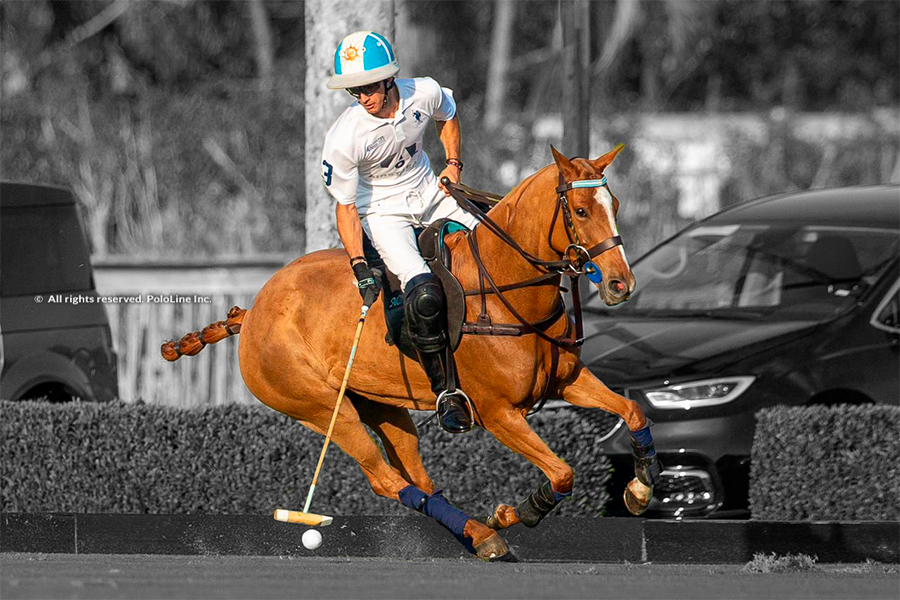DYNAMIC MOVEMENTS IN THE POLO PONY: THE POWER BEHIND THE GAME
By Eduardo Amaya
Introduction
In the intensity of the game—where speed and precision converge—the polo pony becomes a top-tier athlete whose energy is just as decisive as the skill of the rider. This energy, initially perceived as subtle pressure or vibration, is transformed into action under the rider’s control. It is shaped, directed, and projected—forward, laterally, or even held in place—depending on what the game demands.
Understanding this upward and forward transfer of force is essential when analyzing the powerful movements that distinguish the great polo ponies. Every explosive start, sudden change of direction, or powerful push isn’t just raw force—it’s a refined biomechanical expression that sets the tempo of the match. This note aims to explore those energetic movements: precise footfalls, sudden bursts, and split-second adjustments that turn a good pony into a true phenomenon.
FOOTFALLS AND DRIVE IN THE DYNAMIC MOVEMENTS OF THE POLO PONY
The best polo ponies share a trait that’s invisible yet palpable: well-directed energy in every movement.
This energy begins with how they place their limbs on the ground—and how they convert that placement into effective drive. In my view, a polo pony’s skill lies in how it sets its limbs during play. Energetic movement requires rhythm, synchronization, and efficiency—all of which contribute to directed energy. For this, each footfall should be short, powerful, and precise. From a balance perspective, these are low, grounded movements.
The drive, which follows the footfall, should come continuously from each limb—front and hind alike. In straight-line acceleration, the hoof acts like a clamp gripping and pushing off the ground. In lateral moves or turns, the power originates from the shoulder and outer quarters of the hoof. This drive—executed after a correct footfall—is what separates an average pony from a standout. It’s that sense of centrifugal or curved force riders often talk about without knowing exactly what they’re feeling.
A player who understands balance in the footfall, the mechanics of the drive, and how energy is channeled will find the game becomes more intuitive.
What is a Footfall?
During play, a footfall is the contact of one or more limbs with the ground, essential for supporting, balancing, and propelling the body forward (drive). It includes:
Initial Contact
Midstance (load and shock absorption)
Takeoff Phase (impulse and release)
What is Drive?
Drive is the force with which the horse pushes off the ground to move. It’s what you feel when the pony accelerates, turns, or stops. A good drive involves flexing the hind limbs (and, to a lesser extent, the forelimbs) and then extending them powerfully. The hoof literally pushes off the ground.
What is Directed Energy?
Directed energy is the pony’s ability—guided by the rider’s subtle cues—to generate purposeful power and channel it efficiently toward the goal, whether it’s to accelerate, check, turn, or maintain rhythm. It’s power with purpose, force with control, action with intent. Proper footfall is the birthplace of directed energy. The drive is the horse’s immediate reaction to it.
How Does a Rider Feel Directed Energy?
A well-balanced, willing pony responds firmly and without hesitation to even the lightest aid. There’s no lag—the hoof hits, the body drives, and the horse positions itself exactly where the rider asks.
The pony’s body flows in the chosen direction. Acceleration is clean, direct, and aligned (the pony follows its nose). If asked to stop, the horse collects its energy—like it’s sitting into its hind end—creating a wrapped-up feeling, ready for the next move. Directed energy is what separates a powerful yet unbalanced horse from one that uses every ounce of energy with efficiency. Where one leaks power through poor mechanics and imbalance, the other becomes a seamless extension of the rider.
Conclusion
In the polo pony, energy isn’t just released—it’s felt, organized, and transformed into play. To understand its biomechanics is to understand the dynamic soul of the sport. In every footfall, drive, turn, takeoff, or stop, the polo pony doesn’t just move—it expresses energy that the rider must perceive as an extension of their own body. To understand this is to begin hearing the invisible language of the game.
